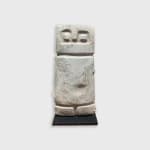Valdivia Culture
This Valdivian Stone sculptures are among the oldest of artefacts found in the Americas. This fine example leaves much to be appreciated, its timeless abstract aesthetic is so in tune with our modern sensibilities despite the fact that it is over 4,000 years old. The owl was widely symbolic in the pre-Columbian world. Owls were considered Shamanic, guiding humans on their journeys to other worlds, the divine, and death. In some cultures, an anthropomorphic owl represented a warrior or war god. As a nocturnal bird of prey, the owl was also associated with night hunters, seeing in darkness and the Underworld of the spirit.



